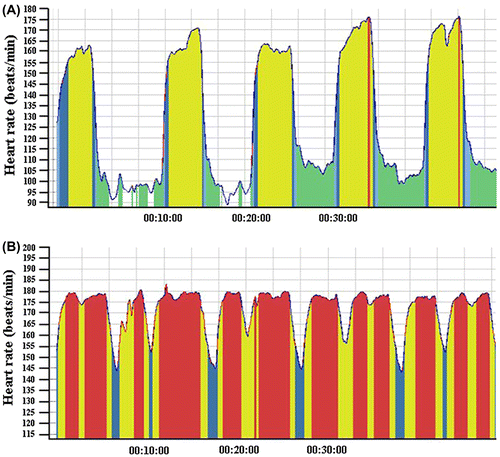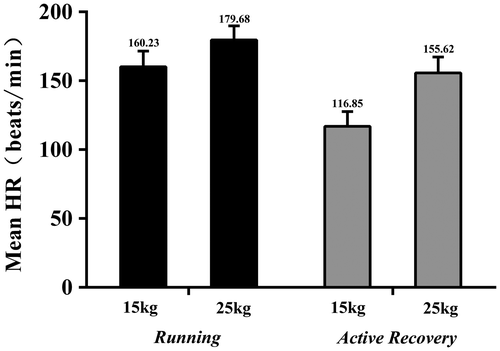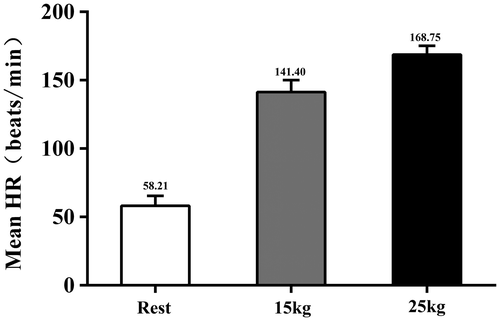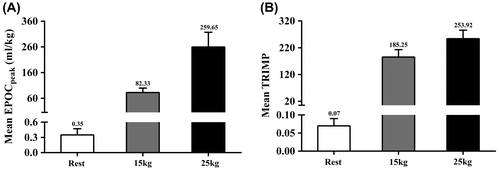Abstract
Purpose: The high injury rate among military populations has been associated with frequent load carriage activities. This study aimed to evaluate changes in postural sway responses to moderate and high intensity interval military load carriage activity under 15 or 25 kg load conditions. Methods: The study utilized a randomized crossover design. Sixteen healthy young males performed military load carriage activity twice (a 15 km moderate intensity interval military load carriage activity under 15 kg or a high intensity interval military load carriage activity with a 25 kg load). The internal load was analyzed using Firstbeat SPORTS. The center of pressure (CoP) movements was analyzed by calculating the average velocity of the CoP movement and direction (with 60 s). Results: Although the mean heart rate, excess post-exercise peak oxygen consumption and training impulse significantly increased (p < 0.05), the mean CoP related parameters for the 15 km high intensity interval military load carriage activity under 25 kg load conditions were not significantly changed compared to rest and 15 km moderate intensity interval military load carriage activity under 15 kg load condition (p ≥ 0.05). Conclusion: As the total training load increased, the ability to control posture based on the demands of a concurrent task is maintained, suggesting that good postural adaptations could also occur.
Public Interest Statement
Load carriage has been shown to be an essential aspect of military occupation. The main objectives of this work were to investigate the postural sway response to acute 15 km moderate or high intensity interval military load carriage activity under 15 or 25 kg load condition. The results showed that the postural stability is able to keep successfully in spite of increased total training load. This specific adaptation may be related to the military load carriage training. It may provide useful knowledge for designing training programs for specific military load carriage activity.
Competing Interests
The authors declare no competing interest.
1. Introduction
Military personnel are required to carry occupational loads and complete tasks in hostile and unpredictable environments in which a lack of mobility may risk lives (Carlton & Orr, Citation2014). While task-dependent, the cumulative impact of these stores and equipment can result in soldiers carrying loads of approximately 50 kg on military operations (Orr, Citation2010). Distances that soldiers move under loaded conditions could range from a 20 m walk across a compound to a march of over 120 km across enemy territory (Orr, Citation2012). Previous research has demonstrated a substantial impact of load carriage on physiological, metabolic, and performance variables following aerobic tasks (e.g., road marching) or anaerobic tasks (e.g. obstacle course negotiation) (Carlton & Orr, Citation2014). Consequently, these occupational load carriage tasks have negative consequences, including decreased mobility, increased fatigue, foot blisters, spinal injury and degeneration, muscle tightness, and soreness of the legs, feet, back and shoulders (Knapik, Citation2014; Nindl et al., Citation2013).
Furthermore, the body’s biomechanical responses to load carriage tasks have also been widely investigated, including the impact of load on posture and gait and ground reaction forces (Orr, Citation2012). Among these changes, an important biomechanical change to posture that is induced by load carriage is the carrier’s forward lean increase (Knapik, Reynolds, & Harman, Citation2004). This posture adjustment may serve as a compensatory change to increase body stability (Polcyn, Bensel, Harman, & Obusek, Citation2000). Posture and balance control are fundamental in daily life to safely accomplish any kind of movement or motor task involving the displacement of body segments or the whole body (Haddad, Rietdyk, Claxton, & Huber, Citation2013). The ability to control posture based on the demands of a load carriage task may be associated with injury development (Orr, Pope, Johnston, & Coyle, Citation2014). Thus, during load carriage running, the postural sway may be impaired; the increased load carriage may result in greater postural sway. Such information may be used to inform interventions designed to minimize these potentially detrimental posture controls.
Thus, the aim of this study was to assess the influence of 15 km moderate or high-intensity interval military load carriage activity under 15 or 25 kg load conditions on postural sway and to determine whether the increased total training load can greater disturb postural balance, which may increase the risk of injury.
2. Methods
2.1. Ethical approval and participants
Sixteen healthy young male cadets (age: 21.23 ± 2.09 years, height: 176.18 ± 3.53 cm, body mass: 69.91 ± 5.21 kg and BMI: 22.51 ± 1.26 kg m−2) who were in full training were recruited to participate in this study. None of the subjects had any current or prior chronic disease, a history of smoking or current use of any medications. Written informed consent was obtained from all participants. Ethical approval for this study conformed to the standards of the Declaration of Helsinki, and the protocol was approved by the Institutional Review Board of PLA Army Engineering University.
2.2. Experimental trial
The military load carriage activity was performed 3 days following the incremental exercise test to eliminate the effect of transient metabolic changes, which continue for a period post-exercise.
On two separate days, each subject randomly completed a 15 km moderate or high-intensity interval military load carriage activity under 15 kg (fighting load) and 25 kg (marching load) conditions commonly used in China at the field environment (Yu & Lu, Citation1990). The 15 km moderate-intensity interval military load carriage activity under the 15 kg load condition consisted of 8 intervals of 5 min of running interspersed with 5 min of active rest, in addition to a 10 min warm-up and a 5 min cooldown. The 15 km high-intensity interval military load carriage activity under the 25 kg load condition consisted of 13 intervals of 5 min of high-intensity running interspersed with 2 min of active rest, in addition to a 10 min warm-up and a 5 min cooldown.
The temperature was between 19 and 22°C, and relative humidity was between 40 and 50%. All sessions were performed at the same time of day (±0.5 h) to minimize the effects of diurnal variations on the measured variables.
2.2.1. Maximal heart rate test
The maximal heart rate (HRmax) was defined as the highest 5 s average during an incremental exercise test using a Polar pulse meter (Polar Electro, Lake Success, NY).
2.2.2. The training internal load
The HR recorded continuously using a real-time HR monitor (Polar TEAM Heart Rate Monitor, Finland) and included the participant’s baseline HR and the exercise sessions. The training internal load was analyzed using the Firstbeat SPORTS software program (version 4.4.0.2, Firstbeat Technologies Ltd., Jyväskylä, Finland). The training load variables included the average heart rate (HR), excess post-exercise peak oxygen consumption (EPOCpeak) and training impulse (TRIMP).
2.2.3. Postural stability
The center of pressure (CoP) measurements were performed using a portable force plate (Kistler, Winterthur, Switzerland). Data were over-sampled at 1,000 Hz and then low-pass filtered (2nd order Butterworth, 50 Hz cutoff) and stored on a laptop for later analysis. The force plate’s load cells were tested for accuracy and precision before each data collection by applying forces to the plate along each edge and each corner.
During postural stability testing, the subjects were instructed to stand upright in a relaxed stance, with their feet planted at shoulder width and with their hands positioned at their sides in a quiet stance. The CoP was recorded for 20 s under eyes-opened conditions, a 1-inch diameter blue marker was placed at eye level on a blank white wall located 2 meters from the subject to provide a visual reference point. Before the exercise, the CoP was recorded three times, with a 5 min break (seated) between the trials; the mean CoP related parameters were used as the rest value. Immediately after exercise (60 s), the CoP was recorded. All parameters were calculated as an average value of the middle 10-s interval.
The signals were analyzed using specialized software (MARS, Kistler, Winterthur, Switzerland) calculating the following parameters: the average CoP movement velocity (CoPV), average CoP movement velocity in the a-p direction (CoPVa-p), average CoP movement velocity in the m-l direction (CoPVm-l), average CoP amplitude in the a-p direction (CoPAa-p), average CoP amplitude in the m-l direction (CoPAm-l), average frequency of the CoP movement direction changes in the a-p direction (CoPFa-p), average frequency of the CoP movement direction changes in the m-l direction (CoPFm-l), average CoP movement path (CoPP), average CoP movement path in the a-p direction (CoPPa-p), average CoP movement path in the m-l direction (CoPPm-l), and CoP movement area in a 100% ellipse (CoPE).
2.3. Statistical analyses
Data are presented as the mean and SD. The difference in the training internal load and CoP related parameters variables was assessed using a one-way repeated-measures analysis of variance with pairwise comparisons (Tukey’s post hoc test). Statistical significance was accepted at p < 0.05. Data analysis was done using SPSS version 20.
3. Results
3.1. Performance and training internal loads
The average running time for the under 15 kg load condition was 75.24 ± 5.32 min, and the average running time for the under 25 kg load condition was 94.26 ± 7.65 min, following a 15 km interval military load carriage activity. The average HRmax was 198.38 ± 9.33 beats/min. Figure showed the exercise mode for each interval military load carriage activity.
Figure 1. HR curves for a representative subject performing a 15 km moderate (A) or high (B)-intensity interval military load carriage activity under 15 kg load or 25 kg load condition.

The mean running intensity for the 15 km exercise under the 15 kg load condition was 81% of the HRmax, and the mean intensity of active recovery was approximately 59% of the HRmax; the running intensity was moderate (Moholdt, Madssen, Rognmo, & Aamot, Citation2014; Nybo et al., Citation2010) (Figure ). The mean running intensity for the 15 km exercise under the 25 kg load condition was 91% of the HRmax, and the mean intensity of active recovery was approximately 78% of HRmax; the running intensity was high (Moholdt et al., Citation2014; Nybo et al., Citation2010) (Figure ). In addition, between the 15 km under 15 kg load and 25 kg load condition trials, there was a significant difference in the HRs measured during the running and active recovery periods (p < 0.001) (Figure ). There was also a significant difference in the mean HR measured during the entire exercise session between the rest period and the 15 km under 15 kg load and 25 kg load conditions.
Figure 2. HR changes for running intensity and active recovery following the 15 km moderate or high-intensity interval military load carriage activity under the 15 kg load or 25 kg load condition.

Figure 3. HR measurements during the entire military load carriage activity between the rest period, 15 km under 15 kg load or 25 kg load condition (n = 16).

During the entire exercise session, there was also a significant difference between the rest period, 15 km under 15 kg load and 25 kg load conditions in terms of the mean EPOCpeak and TRIMP measurements taken (p < 0.001) (Figure ).
3.2. Postural control
No difference was observed between the baseline, 15 kg load and 25 kg load conditions in any CoP parameter following acute 15 km moderate or high-intensity interval military load carriage activity (p ≥ 0.05) (Table ), suggesting that with the training internal load significantly increased, the ability to maintain stable upright posture was not compromised at any direction under eyes-opened conditions.
Table 1. Changes of CoP parameters between baseline, 15 kg load and 25 kg load condition (n = 16)
4. Discussion
It is known that each sport stimulates certain sensory-motor chains (i.e., somatosensory, vestibular, or visual) and, thus, engenders preferential postural strategies for a given postural condition (Paillard, Citation2017). Differences in postural sway can also be observed after exercise with different forms of muscle contractions and different muscle fibers activated (Zemkova & Hamar, Citation2014). Posture control is complex (Paillard, Citation2017; Zemkova & Hamar, Citation2014). In the present study, as the total training load increased, the ability to control posture based on the demands of a concurrent task was maintained under eyes-opened conditions, suggesting that good postural adaptations could also occur.
Load carriage is an essential aspect of soldiering during military operations (Carlton & Orr, Citation2014; Knapik, Citation2014; Knapik et al., Citation2004; Nindl et al., Citation2013; Orr, Citation2010, Citation2012) which involves the complex posture and balance control. It is important for requiring an additional level of postural performance (Knapik et al., Citation2004; Seay, Citation2015). Soldiers explicitly focus on increased step rate, decreased stride length, and more trunk lean, with increased pack-borne loads at the base of support (Knapik et al., Citation2004; Seay, Citation2015), which require good control of body center of mass (COM) movements or CoP and are, thus, theoretically relevant to developing postural abilities. A previous study has shown that “well-being” physical activities that challenge postural balance also improve postural performance (to varying degrees), depending on the postural conditions (Paillard, Citation2017). The induced postural adaptations are specific to the context in which the physical activity is practiced, and chronic/regular physical activity improves postural balance by inducing positive functional adaptations to the postural function (Paillard, Citation2017). Given that participates in present study had more experience for military load carriage activity, our evidence supporting these unique adaptations may include various anatomical and functional characteristics, suggesting that load carriage may be a better physical activity to improve postural performance, while its efficiency compared to that of balance training or other physical activities remains to be established. Further studies are required to clarify these findings.
Furthermore, as posture and balance control involve gathering information (sensory functions), processing this information and commanding action (central integration), as well as motor action (motor function), the possible adaptations of the postural function related to motor experience primarily involve neurophysiological components (i.e., the neural loops involved and their sensory receptors), cognitive function relative to body representation in space (cortical regulation) and motor function (muscle command) (Paillard, Citation2017; Zemkova & Hamar, Citation2014). It has been postulated that sport-specific balance develops specific postural skills (Paillard, Citation2014, Citation2017; Zemkova, Citation2014).
In addition, it is also known that short-term intensive exercises or prolonged exercise can disturb postural balance by degrading the effectiveness of sensory inputs and motor output of the postural function (Zemkova, Citation2014). The increased total training load may result in greater postural sway associated with the increasing risk of injuries. However, in the present study, they have a better ability to maintain balance in these specific conditions, which may be associated with the special running biomechanics and individual training status.
5. Conclusion
In conclusion, although HR, EPOC and TRIMP significantly increased, postural sway was not impaired. Rapid readjustment of balance to baseline after sport-specific exercise is considered to be an important ability (Zemkova, Citation2014). Its impairment can affect outcomes and may also increase the risk of injuries (Zemkova, Citation2014). They exhibit better postural performance and postural adaptations that could have an important implication on designing training programs. In keeping with the concept of specificity, specific load carriage conditioning is needed. Nevertheless, given that occupational load carriage has the potential to cause injuries (Carlton & Orr, Citation2014; Knapik, Citation2014; Knapik et al., Citation2004; Nindl et al., Citation2013; Orr, Citation2010, Citation2012; Orr et al., Citation2014), further studies are needed to evaluate postural sway response to more prolonged exercise or heavy load carriage.
Funding
The authors acknowledge that this work was supported by the Research Special Fund for PLA University of Science and Technology; The Research Innovation Program for College Graduates of Jiangsu Province [grant number KYLX16_1344]; The Research Program for Military College Graduates in china [grant number 2016JY374].
Additional information
Notes on contributors
Zeng Gang Wang
Zeng Gang Wang is a graduate student at the PLA Army Engineering University who has a strong interest in military physical training plan. He is also a member of the Research Center of Military Physical Adaptation Training and the Lab of Military Physical Conditioning and Motor Function Assessment. He received his engineering degree from the PLA University of Science and Technology, and then worked as an officer in the PLA Army Engineering University. In recent years, his research fields are optimizing military physical readiness and preventing musculoskeletal injuries.
References
- Carlton, S. D., & Orr, R. M. (2014). The impact of occupational load carriage on carrier mobility: A critical review of the literature. International Journal of Occupational Safety & Ergonomics, 20(1), 33–41. doi:10.1080/10803548.2014.11077025
- Haddad, J. M., Rietdyk, S., Claxton, L. J., & Huber, J. E. (2013). Task-dependent postural control throughout the lifespan. Exercise & Sport Sciences Reviews, 41(2), 123. doi:10.1097/JES.0b013e3182877cc8
- Knapik, J. J. (2014). Injuries and injury prevention during foot marching. Journal of Special Operations Medicine A Peer Reviewed Journal for Sof Medical Professionals, 14(4), 131–135.
- Knapik, J. J., Reynolds, K. L., & Harman, E. (2004). Soldier load carriage: Historical, physiological, biomechanical, and medical aspects. Military Medicine, 169(1), 45–56. doi:10.7205/MILMED.169.1.45
- Moholdt, T., Madssen, E., Rognmo, O., & Aamot, I. L. (2014). The higher the better? Interval training intensity in coronary heart disease. Journal of Science & Medicine in Sport, 17(5), 506–510. doi:10.1016/j.jsams.2013.07.007
- Nindl, B. C., Castellani, J. W., Warr, B. J., Sharp, M. A., Henning, P. C., Spiering, B. A., & Scofield, D. E. (2013). Physiological Employment Standards III: Physiological challenges and consequences encountered during international military deployments. European Journal of Applied Physiology, 113(11), 2655–2672. doi:10.1007/s00421-013-2591-1
- Nybo, L., Sundstrup, E., Jakobsen, M. D., Mohr, M., Hornstrup, T., Simonsen, L., & Krustrup, P. (2010). High-intensity training versus traditional exercise interventions for promoting health. Medicine & Science in Sports & Exercise, 42(10), 1951–1958. doi:10.1249/MSS.0b013e3181d99203
- Orr, R. (2010). The history of the soldier’s load. Australian Army Journal, VII(2), 67–88.
- Orr, R. M. (2012). Soldier load carriage: A risk management approach (PhD Thesis). The University of Queensland.
- Orr, R. M., Pope, R., Johnston, V., & Coyle, J. (2014). Soldier occupational load carriage: A narrative review of associated injuries. International Journal of Injury Control & Safety Promotion, 21(4), 388–396. doi:10.1080/17457300.2013.833944
- Paillard, T. (2014). Sport-specific balance develops specific postural skills. Sports Medicine, 44(7), 1019–1020. doi:10.07/s40279-014-0174-x
- Paillard, T. (2017). Plasticity of the postural function to sport and/or motor experience. Neuroscience & Biobehavioral Reviews, 72, 129–152. doi:10.1016/j.neubiorev.2016.11.015
- Polcyn, A. F., Bensel, C. K., Harman, E. A., & Obusek, J. P. (2000). The effects of load weight: A summary analysis of maximal performance, physiological and biomechanical results from four studies of load carriage systems. Natick, MA: US Army Natick Soldier Center and US Army Research Institute of Environmental Medicine.
- Seay, J. F. (2015). Biomechanics of load carriage-historical perspectives and recent insights. Journal of Strength & Conditioning Research, 29(Suppl 11), S129–133. doi:10.1519/JSC.0000000000001031
- Yu, Y. Z., & Lu, S. M. (1990). The acceptable load while marching at a speed of 5 km h-1 for young Chinese males. Ergonomics, 33(7), 885–890. doi:10.1080/00140139008925296
- Zemkova, E. (2014). Author’s reply to Paillard T: “Sport-specific balance develops specific postural skills”. Sports Medicine, 44(7), 1021–1023. doi:10.1007/s40279-013-0129-7
- Zemkova, E., & Hamar, D. (2014). Physiological mechanisms of post-exercise balance impairment. Sports Medicine, 44(4), 437–448. doi:10.1007/s40279-014-0175-9

